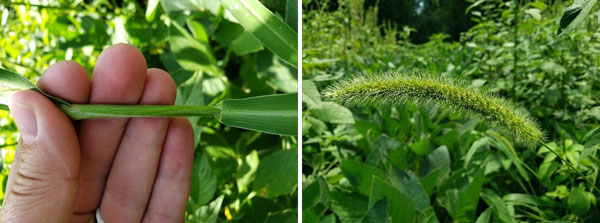Green foxtail (S. viridis), yellow foxtail (S. pumila), and giant foxtail (S. faberi) are three closely related annual weeds that can be found throughout Kansas. This article will discuss identification and control of these troublesome grasses. Other names for these plants include bristlegrasses or millets.
Ecology of foxtails
The foxtail species discussed in this article are all annual plants native to Eurasia. There is one foxtail species native to North America, knotroot foxtail, a perennial that is more commonly found in pastures. The annual foxtails discussed here are found on every continent (except Antarctica) and in every state. They can be found throughout Kansas in cultivated fields, pastures, lawns, roadsides, and other disturbed areas. Annual foxtail species were most likely introduced with European immigrants. Giant foxtail quickly became established in agronomic systems as 2,4-D became widely used to remove broadleaf weed species in corn and cereal grains. Foxtail seed can survive up to 30 years in the soil, but typically persist for three years or fewer. Seeds are eaten by many birds and the plants provide some habitat for pheasants and quail; however, bristles may injure grazing animals.
Foxtail species are able to emerge in soil temperatures as low as 33 F, but most emerge in early April. Seedlings have first leaves that are wider than they are long and nearly parallel to the ground.
Identification
There are two keys to identifying foxtail seedlings, ligules and leaf hairs (Figure 1). All three species have a fringed ligule; however, there are some differences among them (Table 1). In addition, all three species have hairs either on the leaf blade or sheath, with giant foxtail having short hairs covering the upper leaf surface and yellow foxtail have a few wispy hairs at the base of the leaf, while green foxtail leaves are hairless.
Foxtails are easily identified by their bristly, cylindrical panicles that develop as the days get shorter. Panicles are made of many spikelets, which each produce one ovate-shaped, wrinkly seed. Several bristles are attached at the base of each spikelet.

Figure 1. Giant foxtail collar region (left) and panicle (right). Note the membranous ligule with a fringe of hairs and the hairy sheath margins. Photos by Sarah Lancaster, K-State Research and Extension.
Table 1. Key features that distinguish among common foxtail species
|
|
Giant foxtail |
Green foxtail |
Yellow foxtail |
|
Height |
Commonly 1.5 to 3 feet, up to 6.5 feet |
10 inches to 2 feet |
Commonly 1 to 2.5 feet, up to 4 feet |
|
Leaves |
Fine hairs cover upper surface |
No hairs |
Long hairs at base |
|
Sheath |
Round, hairy margins |
Margins hairy |
Flat, no hairs, base may be red/purple |
|
Ligule |
Membrane with fringe of hairs, 1 to 3 mm |
Dense fringe of hairs,1 to 2 mm |
Membrane with fringe of hairs, <1 mm |
|
Panicle |
1 to 8 inches long, often droopy, 2 to 6 bristles per spikelet |
1 to 6 inches long, 1 to 3 bristles per spikelet |
Erect, stiff, 4 to 12 bristles per spikelet |
Management
Foxtail species are especially troublesome in grass crops, such as corn and sorghum, where they compete for water and nutrients, especially nitrogen. Yield reductions between 20 and 80% have been reported for foxtail interference in corn grown in Colorado, Minnesota, Nebraska, South Dakota, and Michigan (Lindquist et al. 1999).
Chemical control of foxtails starts with residual herbicides in Group 15 (Dual Magnum, Harness, Zidua, others) or Group 3 (Prowl H2O, others). Timely application of poste emergence herbicides including glyphosate or herbicides in Group 1 (Select Max, Assure II, others) or Group 2 (Accent, Raptor, others). Several herbicide resistant biotypes of foxtails have been reported in the United States (Table 2).
Table 2. Herbicide resistant annual foxtail biotypes confirmed in the United States
|
|
Herbicide site of action (group) |
Example herbicide(s) |
State(s) |
|
Giant foxtail |
ACCase inhibitors (1) |
Select Max, Assure II |
IL, IA |
|
Giant foxtail |
ALS inhibitors (2) |
Pursuit, Accent Q |
IL, IA, MI, MN |
|
Giant foxtail |
PSII inhibitors (5) |
Atrazine |
IA, MD |
|
Green foxtail |
ACCase inhibitors (1) |
Select Max, Assure II |
MN, WI |
|
Green foxtail |
ALS inhibitors (2) |
Pursuit, Accent Q |
PA, WI |
|
Green foxtail |
Microtubule inhibitors (3) |
Treflan |
ND |
|
Yellow foxtail |
ALS inhibitors (2) |
Raptor |
MN |
|
(Source: www.weedscience.org) |
|||
The use of trade names is for clarity to readers and does not imply endorsement of a particular product, nor does exclusion imply non-approval. Always consult the herbicide label for the most current use requirements.
For more information on controlling foxtails, see 2021 Chemical Weed Control for Field Crops, Pastures, Rangeland, and Noncropland, K-State publication SRP-1162.
Sarah Lancaster, Extension Weed Science Specialist
slancaster@ksu.edu